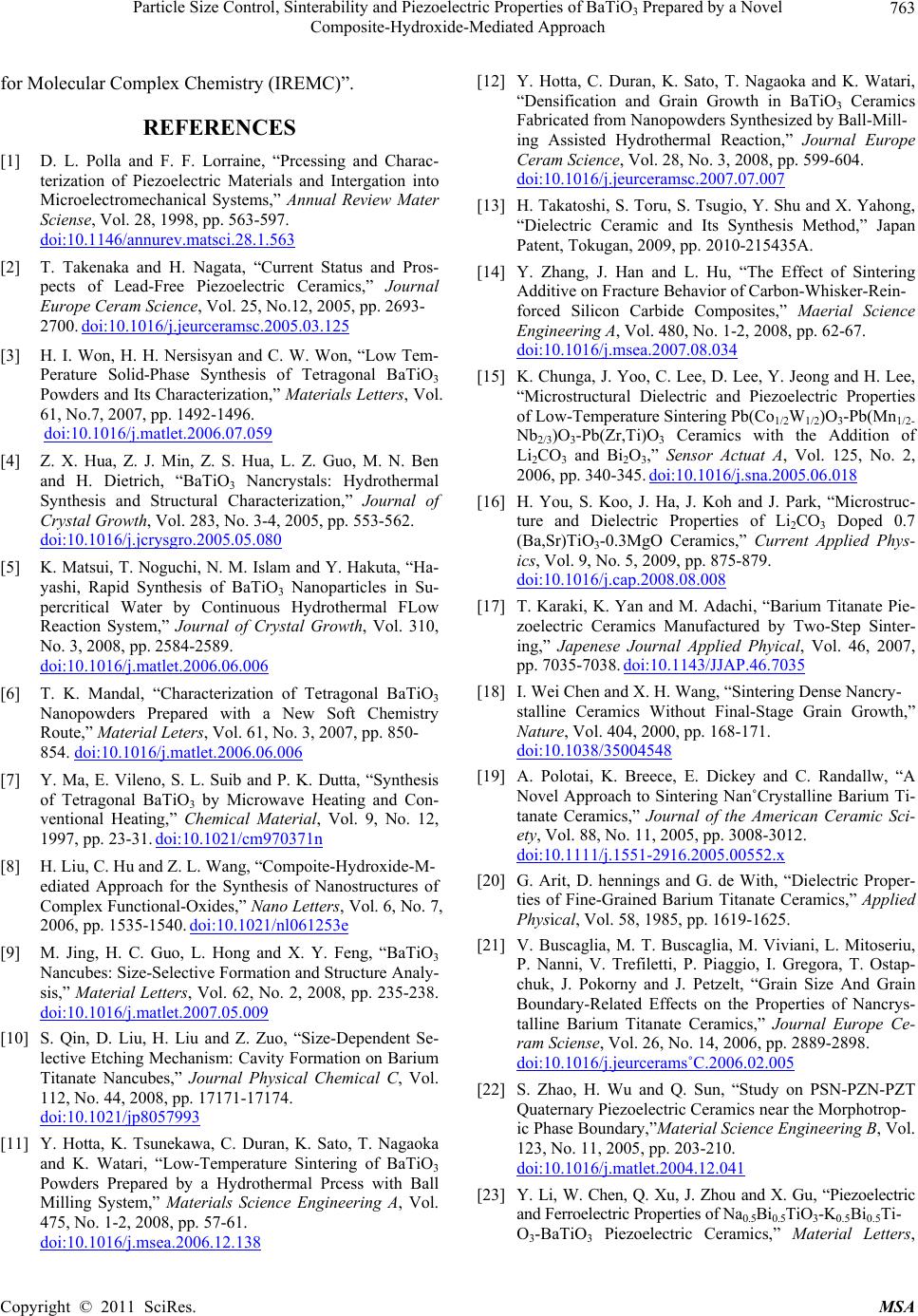
Particle Size Control, Sinterability and Piezoelectric Properties of BaTiO Prepared by a Novel 763
3
Composite-Hydroxide-Mediated Approach
for Molecular Complex Chemistry (IREMC)”.
REFERENCES
[1] D. L. Polla and F. F. Lorraine, “Prcessing and Charac-
terization of Piezoelectric Materials and Intergation into
Microelectromechanical Systems,” Annual Review Mater
Sciense, Vol. 28, 1998, pp. 563-597.
doi:10.1146/annurev.matsci.28.1.563
[2] T. Takenaka and H. Nagata, “Current Status and Pros-
pects of Lead-Free Piezoelectric Ceramics,” Journal
Europe Ceram Science, Vol. 25, No.12, 2005, pp. 2693-
2700. doi:10.1016/j.jeurceramsc.2005.03.125
[3] H. I. Won, H. H. Nersisyan and C. W. Won, “Low Tem-
Perature Solid-Phase Synthesis of Tetragonal BaTiO3
Powders and Its Characterization,” Materials Letters, Vol.
61, No.7, 2007, pp. 1492-1496.
doi:10.1016/j.matlet.2006.07.059
[4] Z. X. Hua, Z. J. Min, Z. S. Hua, L. Z. Guo, M. N. Ben
and H. Dietrich, “BaTiO3 Nancrystals: Hydrothermal
Synthesis and Structural Characterization,” Journal of
Crystal Growth, Vol. 283, No. 3-4, 2005, pp. 553-562.
doi:10.1016/j.jcrysgro.2005.05.080
[5] K. Matsui, T. Noguchi, N. M. Islam and Y. Hakuta, “Ha-
yashi, Rapid Synthesis of BaTiO3 Nanoparticles in Su-
percritical Water by Continuous Hydrothermal FLow
Reaction System,” Journal of Crystal Growth, Vol. 310,
No. 3, 2008, pp. 2584-2589.
doi:10.1016/j.matlet.2006.06.006
[6] T. K. Mandal, “Characterization of Tetragonal BaTiO3
Nanopowders Prepared with a New Soft Chemistry
Route,” Material Leters, Vol. 61, No. 3, 2007, pp. 850-
854. doi:10.1016/j.matlet.2006.06.006
[7] Y. Ma, E. Vileno, S. L. Suib and P. K. Dutta, “Synthesis
of Tetragonal BaTiO3 by Microwave Heating and Con-
ventional Heating,” Chemical Material, Vol. 9, No. 12,
1997, pp. 23-31. doi:10.1021/cm970371n
[8] H. Liu, C. Hu and Z. L. Wang, “Compoite-Hydroxide-M-
ediated Approach for the Synthesis of Nanostructures of
Complex Functional-Oxides,” Nano Letters, Vol. 6, No. 7,
2006, pp. 1535-1540. doi:10.1021/nl061253e
[9] M. Jing, H. C. Guo, L. Hong and X. Y. Feng, “BaTiO3
Nancubes: Size-Selective Formation and Structure Analy-
sis,” Material Letters, Vol. 62, No. 2, 2008, pp. 235-238.
doi:10.1016/j.matlet.2007.05.009
[10] S. Qin, D. Liu, H. Liu and Z. Zuo, “Size-Dependent Se-
lective Etching Mechanism: Cavity Formation on Barium
Titanate Nancubes,” Journal Physical Chemical C, Vol.
112, No. 44, 2008, pp. 17171-17174.
doi:10.1021/jp8057993
[11] Y. Hotta, K. Tsunekawa, C. Duran, K. Sato, T. Nagaoka
and K. Watari, “Low-Temperature Sintering of BaTiO3
Powders Prepared by a Hydrothermal Prcess with Ball
Milling System,” Materials Science Engineering A, Vol.
475, No. 1-2, 2008, pp. 57-61.
doi:10.1016/j.msea.2006.12.138
[12] Y. Hotta, C. Duran, K. Sato, T. Nagaoka and K. Watari,
“Densification and Grain Growth in BaTiO3 Ceramics
Fabricated from Nanopowders Synthesized by Ball-Mill-
ing Assisted Hydrothermal Reaction,” Journal Europe
Ceram Science, Vol. 28, No. 3, 2008, pp. 599-604.
doi:10.1016/j.jeurceramsc.2007.07.007
[13] H. Takatoshi, S. Toru, S. Tsugio, Y. Shu and X. Yahong,
“Dielectric Ceramic and Its Synthesis Method,” Japan
Patent, Tokugan, 2009, pp. 2010-215435A.
[14] Y. Zhang, J. Han and L. Hu, “The Effect of Sintering
Additive on Fracture Behavior of Carbon-Whisker-Rein-
forced Silicon Carbide Composites,” Maerial Science
Engineering A, Vol. 480, No. 1-2, 2008, pp. 62-67.
doi:10.1016/j.msea.2007.08.034
[15] K. Chunga, J. Yoo, C. Lee, D. Lee, Y. Jeong and H. Lee,
“Microstructural Dielectric and Piezoelectric Properties
of Low-Temperature Sintering Pb(Co1/2W1/2)O3-Pb(Mn1/2-
Nb2/3)O3-Pb(Zr,Ti)O3 Ceramics with the Addition of
Li2CO3 and Bi2O3,” Sensor Actuat A, Vol. 125, No. 2,
2006, pp. 340-345. doi:10.1016/j.sna.2005.06.018
[16] H. You, S. Koo, J. Ha, J. Koh and J. Park, “Microstruc-
ture and Dielectric Properties of Li2CO3 Doped 0.7
(Ba,Sr)TiO3-0.3MgO Ceramics,” Current Applied Phys-
ics, Vol. 9, No. 5, 2009, pp. 875-879.
doi:10.1016/j.cap.2008.08.008
[17] T. Karaki, K. Yan and M. Adachi, “Barium Titanate Pie-
zoelectric Ceramics Manufactured by Two-Step Sinter-
ing,” Japenese Journal Applied Phyical, Vol. 46, 2007,
pp. 7035-7038. doi:10.1143/JJAP.46.7035
[18] I. Wei Chen and X. H. Wang, “Sintering Dense Nancry-
stalline Ceramics Without Final-Stage Grain Growth,”
Nature, Vol. 404, 2000, pp. 168-171.
doi:10.1038/35004548
[19] A. Polotai, K. Breece, E. Dickey and C. Randallw, “A
Novel Approach to Sintering Nan˚Crystalline Barium Ti-
tanate Ceramics,” Journal of the American Ceramic Sci-
ety, Vol. 88, No. 11, 2005, pp. 3008-3012.
doi:10.1111/j.1551-2916.2005.00552.x
[20] G. Arit, D. hennings and G. de With, “Dielectric Proper-
ties of Fine-Grained Barium Titanate Ceramics,” Applied
Physical, Vol. 58, 1985, pp. 1619-1625.
[21] V. Buscaglia, M. T. Buscaglia, M. Viviani, L. Mitoseriu,
P. Nanni, V. Trefiletti, P. Piaggio, I. Gregora, T. Ostap-
chuk, J. Pokorny and J. Petzelt, “Grain Size And Grain
Boundary-Related Effects on the Properties of Nancrys-
talline Barium Titanate Ceramics,” Journal Europe Ce-
ram Sciense, Vol. 26, No. 14, 2006, pp. 2889-2898.
doi:10.1016/j.jeurcerams˚C.2006.02.005
[22] S. Zhao, H. Wu and Q. Sun, “Study on PSN-PZN-PZT
Quaternary Piezoelectric Ceramics near the Morphotrop-
ic Phase Boundary,”Material Science Engineering B, Vol.
123, No. 11, 2005, pp. 203-210.
doi:10.1016/j.matlet.2004.12.041
[23] Y. Li, W. Chen, Q. Xu, J. Zhou and X. Gu, “Piezoelectric
and Ferroelectric Properties of Na0.5Bi0.5TiO3-K0.5Bi0.5Ti-
O3-BaTiO3 Piezoelectric Ceramics,” Material Letters,
Copyright © 2011 SciRes. MSA